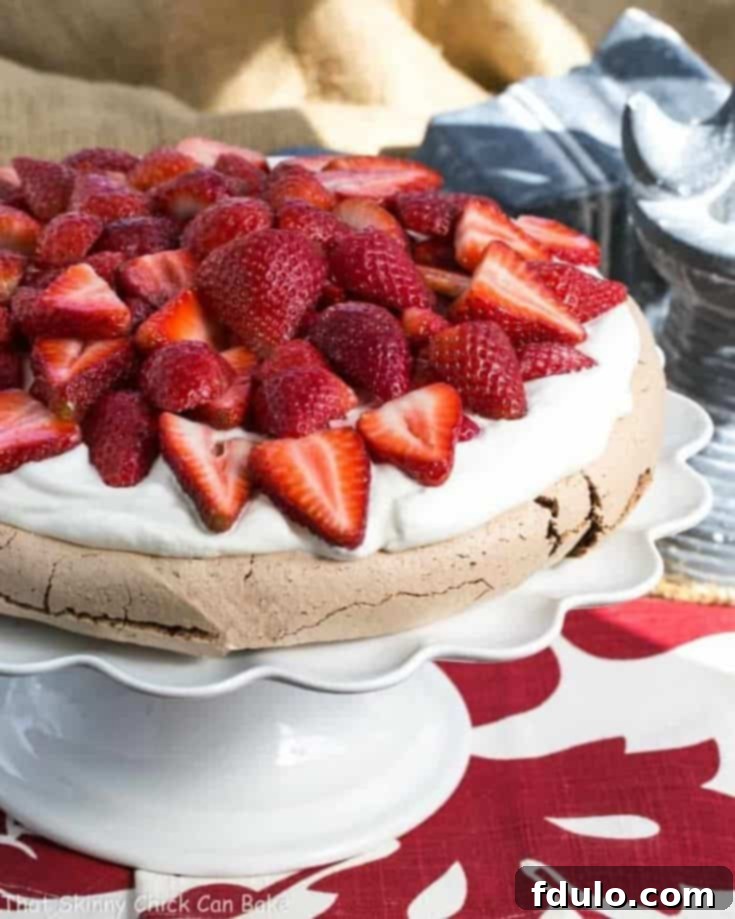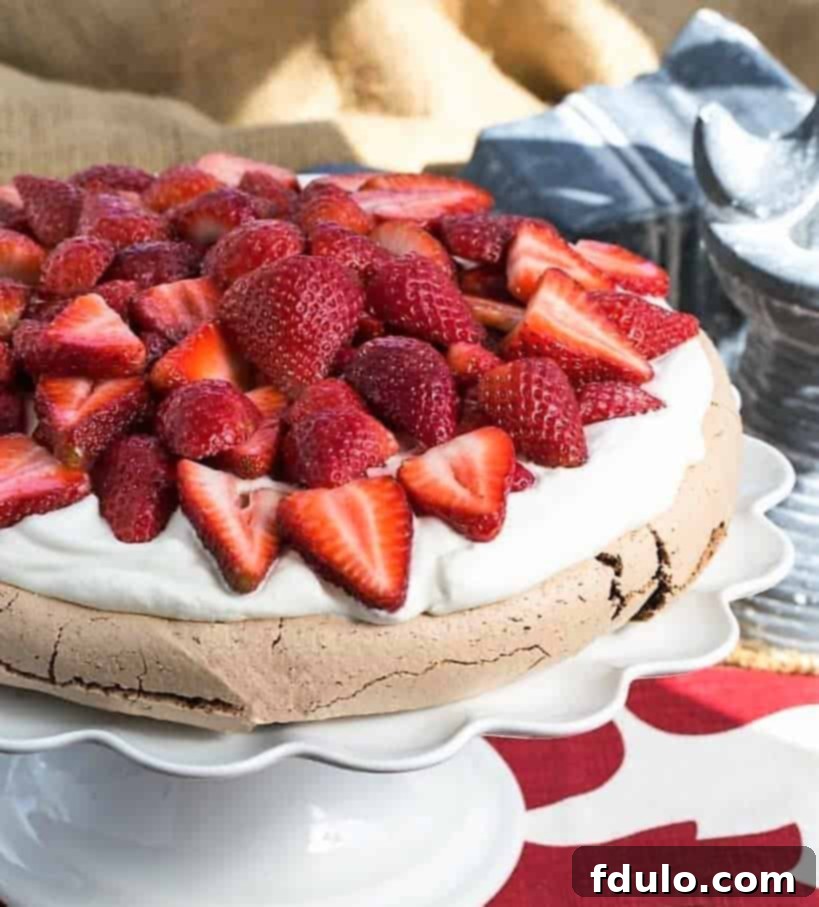Strawberry Topped Chocolate Pavlova with its delicate mascarpone cream and vibrant, sweet strawberries stands as an unparalleled summer dessert. This exquisite creation perfectly showcases the best of seasonal berries, promising a culinary experience that is both elegant and unforgettable.
At the heart of this divine dessert lies a crisp meringue shell, boasting a delightfully chewy, marshmallow-like interior. This unique texture forms the perfect foundation for a luscious topping of rich cream and an abundance of fresh, juicy berries. This Chocolate Pavlova Recipe is a testament to simple ingredients transforming into something truly spectacular.
Why This Chocolate Pavlova Is a Must-Make
Preparing a Pavlova isn’t just baking; it’s crafting a show-stopping centerpiece that captivates both the eyes and the palate. Here’s why this particular chocolate rendition with strawberries deserves a spot on your dessert menu:
- Stunning Visual Appeal: The deep, rich chocolate meringue shell provides a dramatic contrast to the billowy white mascarpone whipped cream, crowned with the vibrant red of fresh strawberries. Its architectural beauty makes it an instant conversation starter and an elegant addition to any gathering.
- A Symphony of Textures and Flavors: Beyond its striking appearance, the Pavlova delivers an incredible textural journey. The exterior shatters with a satisfying crispness, giving way to a soft, yielding, marshmallow-like interior. This is beautifully complemented by the creamy, slightly tangy mascarpone topping and the burst of fresh, sweet-tart berries.
- The Ultimate “Wow” Factor: Many guests may never have experienced a homemade Pavlova, let alone a chocolate and strawberry variation. Serving this dessert guarantees an element of surprise and delight, leaving a lasting impression on everyone who tastes it. It’s a dessert that feels incredibly gourmet yet is surprisingly approachable to create.
- Celebration of Seasonal Produce: This recipe truly shines when made with peak-season ingredients. While strawberries are highlighted here, the versatility of Pavlova allows you to adapt it with any ripe, seasonal berries, ensuring a fresh and vibrant flavor profile every time.
Understanding the Pavlova Tradition

The Pavlova, named after the famous Russian ballerina Anna Pavlova, is a dessert shrouded in a friendly rivalry between Australia and New Zealand, both claiming its invention during her 1920s tours. Regardless of its exact origin, this dessert has become a beloved classic, especially during warmer months.
What sets a Pavlova apart is its unique meringue structure. Unlike a hard, crisp meringue cookie, a true Pavlova features a delicate, crackly crust that encases a soft, almost cloud-like center. This distinct contrast in textures, combined with a generous topping of whipped cream and fresh fruit, creates a light yet indulgent experience that perfectly encapsulates the spirit of celebration.
The addition of cocoa powder and finely chopped chocolate transforms the classic white meringue into a sophisticated chocolate shell, adding depth and richness without overpowering the light, airy texture. This subtle chocolate note pairs exquisitely with the bright acidity of strawberries, creating a harmonious balance that is both comforting and exhilarating.
Mastering the Meringue: Expert Baking Tips
Creating the perfect Pavlova meringue might seem daunting, but with a few key techniques, you can achieve professional-quality results. Follow these essential tips to ensure a beautiful, stable, and perfectly textured chocolate meringue shell:
- Room Temperature Egg Whites are Crucial: For maximum volume and stability, your egg whites must be at room temperature. Cold egg whites are denser and won’t whip up as light and airy, leading to a flatter meringue. Plan ahead and separate your eggs at least 30 minutes to an hour before you begin baking.
- Impeccably Clean Equipment: This cannot be stressed enough. Any trace of grease or oil in your mixing bowl or on your beaters will prevent the egg whites from whipping properly. Even a tiny speck can deflate your efforts. Use a clean, dry metal or glass bowl (plastic bowls can retain grease) and ensure your beaters are spotless. Wiping them down with a lemon wedge or a little vinegar before starting can help.
- Avoid Any Egg Yolk Contamination: Similar to oil, egg yolk contains fat, which is detrimental to meringue formation. Be extremely careful when separating eggs to ensure absolutely no yolk makes it into your whites. If even a tiny bit breaks, it’s best to discard that white and start fresh with a new one.
- Choose Superfine Sugar for Best Results: Superfine sugar (also known as caster sugar) dissolves more quickly and evenly into the egg whites, leading to a smoother, more stable meringue. If you don’t have superfine sugar, you can easily make your own by pulsing regular granulated sugar in a food processor for a minute or two until it’s finer but not powdered.
- Do Not Overbeat the Egg Whites: Overbeating can cause the meringue to become dry and brittle, leading to excessive cracking and potential collapse during baking. Beat until the meringue is stiff and glossy, holding firm peaks, but stops before it looks dull or granular. It should still have a slight sheen.
- Low and Slow for Stable Whipping: Patience is key when beating egg whites. Avoid the temptation to whip on high speed from the start. Begin on low speed, gradually increasing to medium. High-speed whipping can incorporate too much air too quickly, creating large, unstable air pockets that are prone to collapsing. A slower, steady beat builds a stronger, more resilient meringue structure.
- Gradually Add Sugar: Introduce the superfine sugar slowly, one tablespoon at a time, once the egg whites have reached a soft, foamy consistency. This allows the sugar to fully dissolve and integrate into the egg whites, forming a stable meringue. If you add the sugar too quickly or if it doesn’t dissolve completely, your baked pavlova might “weep,” developing sugary water droplets on its surface. This can also happen in very humid conditions, which are generally not ideal for meringue making.
- Secure Your Parchment Paper: To prevent your parchment paper from sliding around on the baking sheet while you’re shaping the meringue, place a small dab of the egg white mixture under each corner of the paper. This acts as a natural adhesive, keeping everything stable.
- Cool Slowly in the Oven: After the baking time is complete, turn off the oven, crack the door open slightly, and allow the Pavlova to cool completely inside the oven. This gradual cooling process prevents drastic temperature changes that can cause the meringue to crack excessively or collapse. If storing the pavlova in the oven to cool, consider putting a reminder note on the oven door to avoid accidentally turning the oven back on while it’s inside – a common mishap that can ruin your beautiful creation!
The Story Behind This Chocolate Pavlova Recipe

My journey into the delightful world of Pavlova began with Nigella Lawson’s renowned chocolate pavlova recipe, typically adorned with luscious raspberries. I remember the excitement of incorporating rich cocoa powder and delicate semisweet chocolate pieces into the meringue, then topping the resulting crisp shell with a heavenly, cloud-like swirl of whipped cream and an abundance of ripe, ruby-red raspberries. The outcome was nothing short of magical, and my family was instantly captivated by its charm and exquisite taste.
Over time, this beloved recipe began its delicious evolution in my kitchen. While raspberries were initially the star, I soon discovered that almost any type of berry could be fair game, each adding its unique flavor dimension. Then came the revelation of adding mascarpone cheese to the whipped cream topping. This simple addition elevated the cream to an entirely new level of richness and stability, transforming an already wonderful dessert into something truly swoon-worthy.
Just recently, during a visit to the local market, I found the raspberries looking rather lackluster and pale. However, the strawberries, oh, the strawberries! They were plump, fragrant, and bursting with vibrant color—absolutely irresistible. It was a clear sign: a strawberry-topped chocolate pavlova was destined for our menu. The decision paid off handsomely, resulting in yet another resounding triumph, showcasing how adaptable and endlessly delightful this dessert can be with whatever fresh, seasonal produce calls to you.
Frequently Asked Questions About Pavlova
A Pavlova is a beautiful, airy dessert consisting of a large meringue base, traditionally topped with whipped cream and fresh fruit. It’s famously named after the legendary Russian ballerina Anna Pavlova, who toured Australia and New Zealand in the 1920s. Both countries passionately claim to be the birthplace of this iconic dessert, though New Zealand often gets the historical edge with the earliest known published recipe dating back to the 1920s. Australia’s first documented recipe appeared slightly later, in the 1940s. Its delicate structure and fresh toppings make it a beloved dish, especially popular during summer months and festive occasions.
While both Pavlova and meringues are delightful desserts primarily made from whipped egg whites and sugar, their textures and intended uses are quite distinct. Meringue cookies, for instance, are typically small, crisp throughout, and melt in your mouth with a delicate sweetness. They are baked until completely dry and crunchy. A Pavlova, on the other hand, is characterized by its unique dual texture: a wonderfully crisp and brittle exterior shell that gives way to a soft, yielding, and chewy interior—often described by culinary experts like Nigella Lawson as “squidgy” or marshmallow-like. This distinct marshmallowy center is what truly defines a Pavlova and differentiates it from a simple meringue.
Serving and Storing Your Strawberry Chocolate Pavlova

To ensure the best experience, it’s ideal to assemble your Pavlova no more than a few hours before serving. This preserves the delicate crispness of the meringue shell and the freshness of the cream and fruit. Once assembled, the moisture from the cream and berries will gradually soften the meringue. While it’s still delicious softened, the textural contrast is best enjoyed fresh.
If you have leftover Pavlova, cover it loosely and refrigerate for up to 1-2 days. The meringue will continue to soften, but the flavors will still be delightful. The un-assembled meringue shell, however, can be stored in an airtight container at room temperature for up to two days, or even longer in a cool, dry place. Just make sure it’s completely cooled and dry before storing. This makes it a fantastic make-ahead dessert for entertaining!
Variations and Other Egg White Recipes You May Also Like
The beauty of Pavlova lies in its adaptability. While this strawberry-topped chocolate version is undeniably spectacular, don’t hesitate to experiment with different seasonal fruits. Peaches and blueberries in summer, figs and plums in autumn, or even tropical fruits like mango and passionfruit can create equally stunning and delicious variations. You can also play with the vinegar type (raspberry, apple cider, or white wine vinegar all work) or add different extracts to the meringue or cream.
For those times you find yourself with extra egg whites after preparing recipes that primarily use yolks—such as rich custards or luxurious creme brulee—Pavlova is an excellent solution. Here are more inspiring recipes:
- Strawberry & Mascarpone Pavlova Recipe from Saving Room for Dessert
- Classic Strawberry Pavlova
- Indulgent Chocolate Raspberry Pavlova
- For a festive touch, try this beautiful Christmas Pavlova Wreath
- Explore more of the Best Dessert Recipes for year-round inspiration.
Connect with us and share your culinary creations! Stay in touch through social media @ Instagram, Facebook, and Pinterest. Don’t forget to tag me when you try one of my recipes! And if you love the results, please give it a 5-star rating in the recipe card below.

Strawberry Topped Chocolate Pavlova Recipe
20 minutes
1 hour 15 minutes
1 hour 35 minutes
10 servings
A large cocoa meringue shell, crisp on the outside and marshmallowy within, topped with a rich mascarpone whipped cream and an abundance of sweet, ripe sliced strawberries.
Ingredients
- 6 large egg whites, at room temperature
- ¼ teaspoon fine salt
- 1 ½ cups superfine sugar (caster sugar)
- ¼ cup good quality unsweetened cocoa powder
- 1 teaspoon raspberry or balsamic vinegar (black currant balsamic works wonderfully)
- ½ teaspoon pure vanilla extract
- 2 ounces semi-sweet chocolate, finely chopped
- 1 ½ cups heavy cream, chilled
- ½ cup Mascarpone cheese, chilled
- ½ cup powdered sugar (confectioners’ sugar)
- 1 teaspoon vanilla extract (for the cream)
- 4 cups fresh sliced strawberries, gently tossed with a tablespoon of granulated sugar
Instructions
- Preheat your oven to 350ºF (175ºC). Line a large baking sheet with parchment paper. Draw a 9-inch (23 cm) circle on the parchment, then flip the paper over so the drawing is on the bottom. Set aside.
- In a very clean, dry mixing bowl, beat the room temperature egg whites on medium-low speed until soft peaks begin to form. Add the salt, then gradually add the superfine sugar, one tablespoon at a time, continuing to beat until the meringue is stiff, glossy, and holds firm peaks. The sugar should be completely dissolved; rub a small amount between your fingers to check for grittiness.
- Sift the cocoa powder over the meringue. Add the vinegar, vanilla extract, and finely chopped semi-sweet chocolate. Gently fold all ingredients together with a spatula until just combined, being careful not to deflate the meringue.
- Carefully pile the chocolate meringue mixture onto the prepared baking sheet, centering it within the 9-inch circle you drew. Use an offset spatula to smooth the top and sides, creating a slight well in the center if desired.
- Place the baking sheet into the preheated oven and immediately decrease the oven temperature to 300ºF (150ºC).
- Bake for 1 to 1¼ hours, or until the edges and top of the meringue are dry and crisp. The Pavlova will likely develop some cracks during baking; this is normal and expected.
- Once baked, turn off the oven, open the oven door a few inches, and allow the Pavlova to cool completely inside the oven. This slow cooling process helps prevent shrinking and cracking.
- To prepare the topping: In a chilled mixing bowl, whip the heavy cream with powdered sugar and vanilla extract until soft peaks form. Gently fold in the chilled mascarpone cream until just combined and smooth. Be careful not to overmix.
- To serve: Carefully transfer the cooled meringue shell to a serving plate. Spoon the whipped mascarpone cream over the top, then generously arrange the sugared sliced strawberries over the cream. Serve immediately and enjoy!
Notes
For the best results, ensure all your baking utensils and mixing bowls are meticulously clean and free from any oil or grease. Even the smallest amount of fat, including a tiny speck of egg yolk, can prevent your egg whites from whipping up properly. This attention to detail is crucial for achieving that signature crisp exterior and soft, marshmallowy interior. This recipe is wonderfully adapted from the classic techniques of Nigella Lawson.
Recommended Baking Essentials
As an Amazon Associate and member of other affiliate programs, I earn from qualifying purchases.
- USA Pan Bakeware Half Sheet Pan
- Reynolds Cookie Baking Sheets Non-Stick Parchment Paper, 25 Sheet, 4 Count
- KitchenAid KSM150PSER Artisan Tilt-Head Stand Mixer with Pouring Shield, 5-Quart, Empire Red
Nutrition Information:
Yield:
10
Serving Size:
1 slice
Amount Per Serving:
Calories: 443Total Fat: 26gSaturated Fat: 16gTrans Fat: 1gUnsaturated Fat: 8gCholesterol: 74mgSodium: 196mgCarbohydrates: 49gFiber: 2gSugar: 45gProtein: 5g
HOW MUCH DID YOU LOVE THIS RECIPE?
Please leave a comment on the blog or share a photo on Pinterest
